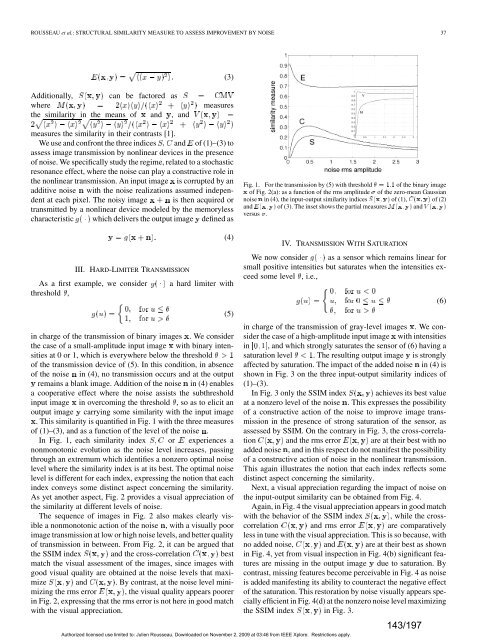a la physique de l'information - Lisa - Université d'Angers
a la physique de l'information - Lisa - Université d'Angers
a la physique de l'information - Lisa - Université d'Angers
Create successful ePaper yourself
Turn your PDF publications into a flip-book with our unique Google optimized e-Paper software.
ROUSSEAU et al.: STRUCTURAL SIMILARITY MEASURE TO ASSESS IMPROVEMENT BY NOISE 37<br />
Additionally, can be factored as<br />
where measures<br />
the simi<strong>la</strong>rity in the means of and , and<br />
measures the simi<strong>la</strong>rity in their contrasts [1].<br />
We use and confront the three indices and of (1)–(3) to<br />
assess image transmission by nonlinear <strong>de</strong>vices in the presence<br />
of noise. We specifically study the regime, re<strong>la</strong>ted to a stochastic<br />
resonance effect, where the noise can p<strong>la</strong>y a constructive role in<br />
the nonlinear transmission. An input image is corrupted by an<br />
additive noise with the noise realizations assumed in<strong>de</strong>pen<strong>de</strong>nt<br />
at each pixel. The noisy image is then acquired or<br />
transmitted by a nonlinear <strong>de</strong>vice mo<strong>de</strong>led by the memoryless<br />
characteristic which <strong>de</strong>livers the output image <strong>de</strong>fined as<br />
III. HARD-LIMITER TRANSMISSION<br />
As a first example, we consi<strong>de</strong>r a hard limiter with<br />
threshold ,<br />
in charge of the transmission of binary images . We consi<strong>de</strong>r<br />
the case of a small-amplitu<strong>de</strong> input image with binary intensities<br />
at 0 or 1, which is everywhere below the threshold<br />
of the transmission <strong>de</strong>vice of (5). In this condition, in absence<br />
of the noise in (4), no transmission occurs and at the output<br />
remains a b<strong>la</strong>nk image. Addition of the noise in (4) enables<br />
a cooperative effect where the noise assists the subthreshold<br />
input image in overcoming the threshold , so as to elicit an<br />
output image carrying some simi<strong>la</strong>rity with the input image<br />
. This simi<strong>la</strong>rity is quantified in Fig. 1 with the three measures<br />
of (1)–(3), and as a function of the level of the noise .<br />
In Fig. 1, each simi<strong>la</strong>rity in<strong>de</strong>x or experiences a<br />
nonmonotonic evolution as the noise level increases, passing<br />
through an extremum which i<strong>de</strong>ntifies a nonzero optimal noise<br />
level where the simi<strong>la</strong>rity in<strong>de</strong>x is at its best. The optimal noise<br />
level is different for each in<strong>de</strong>x, expressing the notion that each<br />
in<strong>de</strong>x conveys some distinct aspect concerning the simi<strong>la</strong>rity.<br />
As yet another aspect, Fig. 2 provi<strong>de</strong>s a visual appreciation of<br />
the simi<strong>la</strong>rity at different levels of noise.<br />
The sequence of images in Fig. 2 also makes clearly visible<br />
a nonmonotonic action of the noise , with a visually poor<br />
image transmission at low or high noise levels, and better quality<br />
of transmission in between. From Fig. 2, it can be argued that<br />
the SSIM in<strong>de</strong>x and the cross-corre<strong>la</strong>tion best<br />
match the visual assessment of the images, since images with<br />
good visual quality are obtained at the noise levels that maximize<br />
and . By contrast, at the noise level minimizing<br />
the rms error , the visual quality appears poorer<br />
in Fig. 2, expressing that the rms error is not here in good match<br />
with the visual appreciation.<br />
(3)<br />
(4)<br />
(5)<br />
Fig. 1. For the transmission by (5) with threshold aIXI of the binary image<br />
of Fig. 2(a): as a function of the rms amplitu<strong>de</strong> ' of the zero-mean Gaussian<br />
noise in (4), the input-output simi<strong>la</strong>rity indices ƒ@Y A of (1), g@Y A of (2)<br />
and i@Y A of (3). The inset shows the partial measures w@Y A and † @Y A<br />
versus '.<br />
IV. TRANSMISSION WITH SATURATION<br />
We now consi<strong>de</strong>r as a sensor which remains linear for<br />
small positive intensities but saturates when the intensities exceed<br />
some level , i.e.,<br />
in charge of the transmission of gray-level images . We consi<strong>de</strong>r<br />
the case of a high-amplitu<strong>de</strong> input image with intensities<br />
in , and which strongly saturates the sensor of (6) having a<br />
saturation level . The resulting output image is strongly<br />
affected by saturation. The impact of the ad<strong>de</strong>d noise in (4) is<br />
shown in Fig. 3 on the three input-output simi<strong>la</strong>rity indices of<br />
(1)–(3).<br />
In Fig. 3 only the SSIM in<strong>de</strong>x achieves its best value<br />
at a nonzero level of the noise . This expresses the possibility<br />
of a constructive action of the noise to improve image transmission<br />
in the presence of strong saturation of the sensor, as<br />
assessed by SSIM. On the contrary in Fig. 3, the cross-corre<strong>la</strong>tion<br />
and the rms error are at their best with no<br />
ad<strong>de</strong>d noise , and in this respect do not manifest the possibility<br />
of a constructive action of noise in the nonlinear transmission.<br />
This again illustrates the notion that each in<strong>de</strong>x reflects some<br />
distinct aspect concerning the simi<strong>la</strong>rity.<br />
Next, a visual appreciation regarding the impact of noise on<br />
the input-output simi<strong>la</strong>rity can be obtained from Fig. 4.<br />
Again, in Fig. 4 the visual appreciation appears in good match<br />
with the behavior of the SSIM in<strong>de</strong>x , while the crosscorre<strong>la</strong>tion<br />
and rms error are comparatively<br />
less in tune with the visual appreciation. This is so because, with<br />
no ad<strong>de</strong>d noise, and are at their best as shown<br />
in Fig. 4, yet from visual inspection in Fig. 4(b) significant features<br />
are missing in the output image due to saturation. By<br />
contrast, missing features become perceivable in Fig. 4 as noise<br />
is ad<strong>de</strong>d manifesting its ability to counteract the negative effect<br />
of the saturation. This restoration by noise visually appears specially<br />
efficient in Fig. 4(d) at the nonzero noise level maximizing<br />
the SSIM in<strong>de</strong>x in Fig. 3.<br />
Authorized licensed use limited to: Julien Rousseau. Downloa<strong>de</strong>d on November 2, 2009 at 03:46 from IEEE Xplore. Restrictions apply.<br />
143/197<br />
(6)


